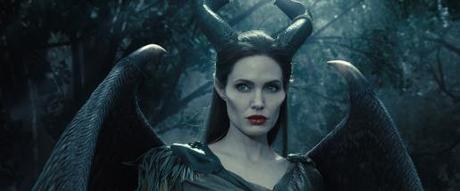
Image from disney.wikia.com
**Warning: Major Spoilers Throughout**
As the movie’s name would suggest, Maleficent focuses on the eponymous character played by Angelina Jolie. The story is touted as a remake of the 1959 Sleeping Beauty, with a poster proclaiming, “Don’t believe the fairy tale.” Disney seems to put a large emphasis on the differences between the two films, and the 2014 version is in many ways the polar opposite of the original. It almost seems as if Disney is making penance for the mistakes of their past, and attempting to fix and subvert the very norms they created. The most obvious example is the overused trope and fix-all of “true love’s kiss.”
Maleficent herself explains to Diaval that she choose true love’s kiss as the metaphorical sniffing salts for a specific reason: she believes it does not exist. Maleficent believed she was in love with Stefan, but this turned out not to be the case. She believes true love’s kiss to be a myth and arousing Aurora to be an impossible task. Nevertheless, after Aurora has fallen into a spinning-wheel induced sleep, Prince Phillip is whisked in by the three dimwitted fairies to kiss her. The fairies ask if he would like to kiss her, and he says he would very much like. However, he would not feel comfortable doing so as he has just met her. After the curse has been explained and the fairies have sufficiently heckled him, he tenderly kisses the sleeping dame. She does not awaken. Enter Maleficent, who delivers a heartfelt and remorseful speech before kissing Aurora on the forehead. Lo and behold, she awakens. Wait a second…isn’t that what happened in Frozen?
Like Frozen, the emphasis is not on true love’s kiss, but true love. It was not Kristoff that saved Anna, but Elsa’s act of love. With Maleficent, it was technically a kiss that revived the sleeping princess. But it was a platonic and motherly kiss from a “fairy godmother,” not an on-the-lips kiss from a lover. After having seen Frozen, Maleficent’s awakening of Aurora seemed like cheap self-plagiarism on the part of Disney. That’s not to say I would have preferred the prince saved her from eternal slumber; but with Frozen melodies still floating around in my head, the “plot twist” did not seem fresh and original. Been there, seen that. Another aspect reminiscent of Frozen was Prince Phillip’s reluctance to kiss the knocked-out Aurora. Admittedly, Prince Phillip was a bit more eloquent in than the adorkable and bumbling Kristoff. However, both characters were very conscious of the need for consent before kissing their love interests. I found this very refreshing in both movies, as it teaches young men and women the necessity of consensual romance.
Another similarity to Frozen is the emphasis placed upon on relationships between women. This is very important in any movie, but especially movies directed towards young audiences. It teaches impressionable children that finding a partner is not the only thing that matters in life. There are many types of love, and non-romantic relationships are just as important as romantic ones. Enter princess movies not focused on princes, the most prominent example being Frozen, which takes as back to Elsa and Anna. The relationship between Anna and Elsa has many layers, because both characters are multidimensional. The same cannot be said for Aurora and Maleficent, as Elle Fanning as Aurora is remarkably simple to understand. In this regard, the movie is true to the 1959 version. Aurora has never really had any depth to her character, never been anything more than a beautiful and kind princess: an archetype of female perfection. Admittedly, there is some depth to the scene when a distressed Aurora lashes out after discovering her “fairy godmother” had cursed her. But to me, Aurora’s reaction seemed more like that of child versus a strong young woman. Not long before her sixteenth birthday, Aurora is still seen innocently frolicking in the Moors with the magical creatures. Personally, I wasn’t given enough to feel that Aurora is truly multidimensional. I found myself hoping she would secretly be a badass and join the fight to save Maleficent, but alas. While Aurora has little character development, Maleficent has the most by a long shot.
The entire movie is dedicated to the supposedly “evil fairy’s” backstory, so naturally Maleficent is the most multidimensional character. Jolie does a marvelous job, but she cannot uphold the entire movie. It also seems quite forced when the voice-over narration points of the multidimensionality inherent in Maleficent. At the end of the movie, Maleficent is described as neither hero nor villain. It is not a false statement, but it’s also completely obvious. The rest of the cast, including Stephen and the blubbering airhead fairies, have no depth. Diavolt was portrayed quite well by Sam Riley, but the character played only a supporting role as Maleficent’ s trusty sidekick. Aside from the characters, the plot seemed somewhat disjointed, with too much expository voice-over narration. The special effects were well done to the point of being overdone. Some parts of the movie, including Maleficent waking up wingless and the battle scenes, were probably quite scary for young children.
Overall, Maleficent is almost nothing like the original. The villain isn’t really a villain at all, and the prince doesn’t save the day. Is this really such a bad thing? It seems Disney sought to subvert the norms of its past, and it certainly did so. There may have been some bumps, but the modern update means the ages old story is finally up to date with modern ideas of what is means to be a villain, and what it means to be in love. With films like Frozen and Maleficent, Disney is righting the wrongs of its past in order to shape the future—children.

